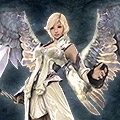Building the Future of Vana'diel
Around the Office
Vana'diel is inhabited by a variety of gods, goddesses and celestial beings, which affect the game's story, history and characters. Behind the scenes, though, there is a sea of cubicles where the real magic happens. This decade strong MMO comes to life for players every day thanks to the tireless efforts of the developers, programmers and artists at the Square Enix headquarters in Tokyo. During our visit, ZAM was able to meet a few of the gods who truly shape the world of Vana'diel.
Character Motions

Youtube: Queen of the Dance
FFXI has always had some of the best cut scenes in MMO gaming. Every year, the detailed movements and expressiveness of characters has only improved. Using the well-known Lilisette dancing scene from Wings of the Goddess Mission 4 - Queen of the Dance as a reference, Motion Designer Ryuichi Onuma took some time to show us how character motions are crafted.
Onuma utilizes two monitors to manipulate and test a character. The left monitor has a 3D model of the character to plot and edit motions, and the right monitor shows how the model will look rendered in-game.

On the left monitor, Saito can pull up a map of the character's various body parts to manipulate. Each point on the character's model can be dragged into position using the mouse, and all connected parts of the model move accordingly. This is used to place the character into specific poses. Each "pose" then becomes a point on a timeline. Essentially, a character's movements are a sequence of poses, and the computer fills in the gaps accordingly with motion.
One of the most amazing things about this process, considering the complexity of some cutscenes in recent years, is that FFXI uses no motion capture technology. Everything is done step by step, pose by pose. "I try to keep everything original," says Onuma. "I'm sure some inspiration from TV or movies I've seen sneaks in, but I strive to create original motions that I think are cool." For Lilisette's dance, Onuma drew some of that inspiration from YouTube, studying videos of sensual dancing to help make Lilisette's big performance a memorable one. "I was a little embarrassed doing that during working hours," confesses Onuma. "People would walk by I'd have to try and hide the screen."
Coordinating the Performers
YouTube: Whispers of Dawn
Once the NPCs have their motions in order, it's time to choreograph how they work together in the scene. When we caught up with Designer Yuko Hatae, she showed how they put together Lilisette's revival scene from Wings of the Goddess mission 47: Whispers of Dawn.
Scenes, like character motions, are plotted out on a timeline, but as Hatae explains, "It's more like a musical score. Different motions and effects are layered on top on each other and play at different times." Designers like Hatae literally orchestrate the various elements of a scene. For example, a shining ball of light gives way to a twirling flower while sparks of light and feathers float upward. All of these are individual effects that play over each other on different timers until they give way to reveal Lilisette, who then begins her own part of the performance. Hatae watches this over and over as the detailed information on these elements flows down the screen.

Coming up with all of these diverse effects is a team effort. "First we have a meeting to discuss the general flow of the scene," states Hatae. "We may then get specific images, such as 'make it like a blooming flower,'" in reference to the aforementioned scene in Witchfire Glen.
Camera Work
YouTube: Howl from the Heavens
Once the stage is set and the elements are in place, it's time to add one more key player: the camera. While it may sound simple, the camera serves to subtly define the atmosphere of a cutscene -- the focus, the importance of objects and NPCs, the flow of events -- all these aspects and more are determined by the careful selection of camera angles.

On Event Director Yoshitsugu Saito's desk sits a small TV that displays detailed information of the inner working of the scene. Using a special dev box, Saito is able to repeatedly play back cutscenes as they will appear on a PlayStation3, XBox360 or Windows PC. He is able to select from over 15 different camera angles to view the action from all sides. When viewing the scene, translucent models for all five races of player character are displayed on the same axis. This allows him to easily see how different sized characters look in relation to surrounding objects and NPCs. For example, during Queen of the Dance, Hume, Elvaan, Mithra and Galka characters stand behind a table to watch Lilisette perform, while diminutive TaruTaru characters sit right upon it. The positioning and motions of fellow tavern-goer Ragelise also need to take this into consideration.

As Lilisette dances onstage, Saito cycles through cameras placed around the tavern. "The movement of the camera angles should complement the movement of the characters," explains Saito. "The camera angles help drive the flow of the scene and the characters."
Pulling up another iconic cutscene from the Wings of the Goddess quest line, Howl from the Heavens, Saito illustrates the importance also of what the player does not see. "Poor camera angle selection will expose parts of the map beyond what is usually visible to the player." The black void on the other side of the Windurst gate would certainly ruin the atmosphere of Karuha-Baruha's big gambit. Saito makes sure the view of the player is always tightly focused on the action.






